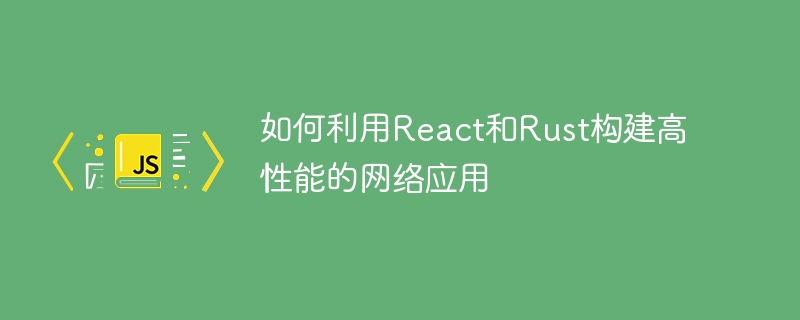

How to use React and Rust to build high-performance network applications
Introduction:
In today's Internet era, the needs of network applications are becoming more and more diverse. ation, the requirements for performance and reliability are also getting higher and higher. React and Rust are two technologies that have attracted much attention in front-end and back-end development. Their combined use can help us build high-performance network applications. This article will introduce how to use React and Rust to develop web applications and provide specific code examples.
1. Introduction to React
React is a JavaScript library used to build user interfaces, developed and open sourced by Facebook. It adopts a component-based development method, splitting the page into multiple reusable components, and interacting and updating through data flow, which improves development efficiency and code maintainability.
1.1 Features of React
2. Introduction to Rust
Rust is a system-level programming language developed by Mozilla and open source. Rust is designed with safety, concurrency and efficiency as its design goals, with guarantees of memory safety and data competition, and the compiled code performance is close to C.
2.1 Features of Rust
3. Use React and Rust to build high-performance network applications
In the development of network applications, React and Rust can be used for front-end and back-end development respectively, through API Data interaction to build high-performance network applications.
3.1 Front-end development
In front-end development, we can use React to build the user interface.
First of all, we can use tools such as Create React App to create a basic React project:
npx create-react-app my-app cd my-app npm start
After creating the project, we can use React's component development method to split the page Divided into multiple reusable components. Data is transferred and updated through state management.
The following is a simple React component example:
import React, { useState } from 'react';
function Counter() {
const [count, setCount] = useState(0);
return (
<div>
<p>Count: {count}</p>
<button onClick={() => setCount(count + 1)}>Increment</button>
<button onClick={() => setCount(count - 1)}>Decrement</button>
</div>
);
}
export default Counter;In the above example, we use the useState hook to define a state count and an update function setCount. By clicking the button, you can increase and decrease the count.
3.2 Back-end development
In back-end development, we can use Rust to write high-performance server programs.
First of all, we can use tools such as Cargo to create a basic Rust project:
cargo new my-app cd my-app cargo build
After creating the project, we can use Rust's concurrency mechanism and network library to achieve high performance server.
The following is a simple Rust server example:
use std::io::prelude::*;
use std::net::{TcpListener, TcpStream};
use std::thread;
fn handle_client(mut stream: TcpStream) {
let mut buffer = [0; 512];
stream.read(&mut buffer).unwrap();
let response = "HTTP/1.1 200 OK
Hello, World!";
stream.write(response.as_bytes()).unwrap();
stream.flush().unwrap();
}
fn main() {
let listener = TcpListener::bind("127.0.0.1:8000").unwrap();
for stream in listener.incoming() {
match stream {
Ok(stream) => {
thread::spawn(move || {
handle_client(stream);
});
}
Err(_) => {
println!("Error");
break;
}
}
}
}In the above example, we created a TcpListener that listens on port 8000. When a new connection comes in, we will open a new thread to process the connection request and return a simple HTTP response.
4. Summary
Using the combined development of React and Rust, we can build high-performance network applications. React provides the ability to quickly build user interfaces, and Rust provides efficient and safe back-end development capabilities. Through reasonable design and optimization, we can realize a network application that is both beautiful and high-performance.
Through the introduction of this article, we have learned about the characteristics of React and Rust, and provided specific code examples, hoping to help readers better use React and Rust to develop network applications.
The above is the detailed content of How to build high-performance web applications with React and Rust. For more information, please follow other related articles on the PHP Chinese website!
 How to create an index in word
How to create an index in word
 ps paint bucket shortcut keys
ps paint bucket shortcut keys
 What should I do if I forget my broadband password?
What should I do if I forget my broadband password?
 The role of Serverlet in Java
The role of Serverlet in Java
 What is the difference between css framework and component library
What is the difference between css framework and component library
 windows automatic update
windows automatic update
 What types of files can be identified based on
What types of files can be identified based on
 How to open psd files
How to open psd files




